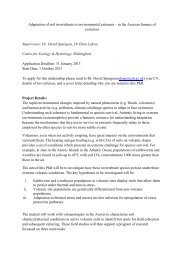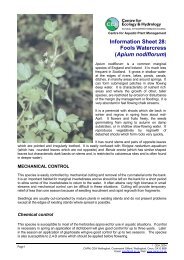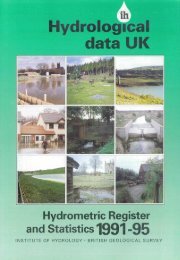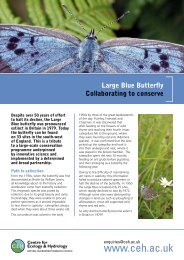ECOFACT Volume 1 Introduction and Approach - Centre for Ecology ...
ECOFACT Volume 1 Introduction and Approach - Centre for Ecology ...
ECOFACT Volume 1 Introduction and Approach - Centre for Ecology ...
You also want an ePaper? Increase the reach of your titles
YUMPU automatically turns print PDFs into web optimized ePapers that Google loves.
Data provided within the PDF files <strong>for</strong> each vegetation class is as follows:<br />
These PDF files contain a two-page summary <strong>for</strong> each of the 100 CVS vegetation classes. The<br />
summary provides a description of each class <strong>and</strong> depicts its extent in GB, its association with the<br />
four l<strong>and</strong>scape types based upon the ITE L<strong>and</strong> Classification of GB, details of plant species<br />
composition, comparisons with the National Vegetation Classification (NVC) (Rodwell 1992), a<br />
characterisation in terms of functional strategy theory (CSR) (Grime et al. 1988), <strong>and</strong> its<br />
relationship to Ellenberg’s indicator values (Ellenberg 1974). The values in the text are those that<br />
have been recalibrated <strong>for</strong> GB (Hill et al. in prep). The layout has been chosen to provide as much<br />
in<strong>for</strong>mation as possible to enable the classification to be used effectively. Each section in the twopage<br />
summary is summarised below.<br />
Description<br />
This section includes the number <strong>and</strong> name of the vegetation class, <strong>and</strong> of the aggregate class to<br />
which it belongs. The names are designed to provide a clear indication of the type of vegetation<br />
<strong>and</strong> an impression of the composition of each class. The naming is as consistent as possible,<br />
depending upon the availability of precise ecological terms, <strong>and</strong> the style follows that of Barr et al.<br />
(1993). Distinct combinations of habitats are used wherever possible, <strong>and</strong> in other cases species<br />
or soil types are included as descriptors. The continuous nature of vegetation inevitably means<br />
that arbitrary, but reproducable, divisions are made, <strong>and</strong>, whilst the names appear similar, the<br />
statistical procedure used to allocate samples is discriminatory. A short paragraph of text<br />
summarises the main features. The names of species given in the description of most frequent,<br />
cover or characteristic species do not always coincide with the lists, as a degree of interpretation<br />
was used to select those indicative of the ecological character of the vegetation class. All species<br />
names are listed according to Dony, Jury <strong>and</strong> Perring (1974), Clapham, Tutin <strong>and</strong> Moore (1989)<br />
<strong>and</strong> Watson (1955).<br />
Associated features<br />
Soils <strong>and</strong> l<strong>and</strong> cover<br />
In Countryside Survey 1990 the l<strong>and</strong> cover, l<strong>and</strong>scape features <strong>and</strong> soils of each 1 km square<br />
were mapped <strong>and</strong> described using a predetermined list of codes. These maps were overlaid with<br />
the locations of the plots sampled <strong>and</strong> the results are summarised in the descriptions, giving the<br />
degree of coincidence between the vegetation classes, soil types <strong>and</strong> l<strong>and</strong> cover types. These were<br />
simplified eg by joining all crops into one type from the list provided by Barr et al. (1993).<br />
Distribution<br />
Total number of plots<br />
The number of plots recorded in 1990 which make up each of the classes provides an objective<br />
measure of their abundance. The larger vegetation classes were relatively uni<strong>for</strong>m <strong>and</strong> clearly<br />
defined; <strong>for</strong> example, vegetation class 10 (tall grass/herb boundaries) consisted of over 800 plots.<br />
However, most of the classes contained only 30–50 plots.<br />
L<strong>and</strong>scape association<br />
The ITE l<strong>and</strong> classes were aggregated into four broad l<strong>and</strong>scape types (arable, pastural, marginal<br />
upl<strong>and</strong> <strong>and</strong> upl<strong>and</strong>), as described by Barr et al. (1993), <strong>and</strong> these have been used to summarise<br />
the distribution of the vegetation classes. The arable l<strong>and</strong>scape is dominated by AC I<br />
(crops/weeds), AC II (tall grassl<strong>and</strong>/herb) <strong>and</strong> AC III (fertile grassl<strong>and</strong>), but it has a small<br />
element of AC VII (moorl<strong>and</strong>/grass mosaic) <strong>and</strong> VIII (heath/bog). The pastural l<strong>and</strong>scape is<br />
similar, but is dominated by AC III <strong>and</strong> has a higher proportion of moorl<strong>and</strong> grass/mosaic. The



![Aquatic bryophytes/lower plants [1.54MB, PDF] - Centre for Ecology ...](https://img.yumpu.com/16155793/1/190x143/aquatic-bryophytes-lower-plants-154mb-pdf-centre-for-ecology-.jpg?quality=85)




